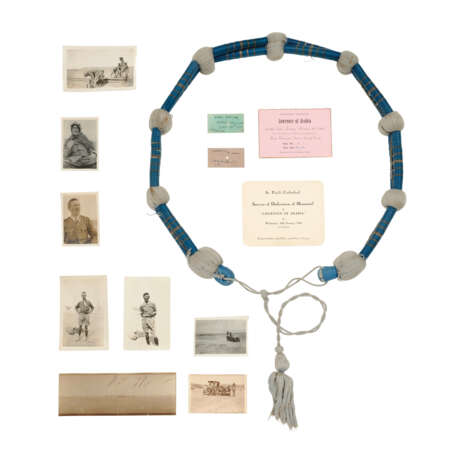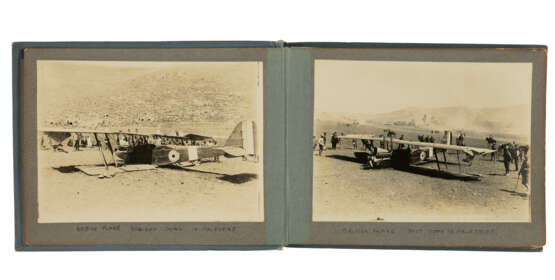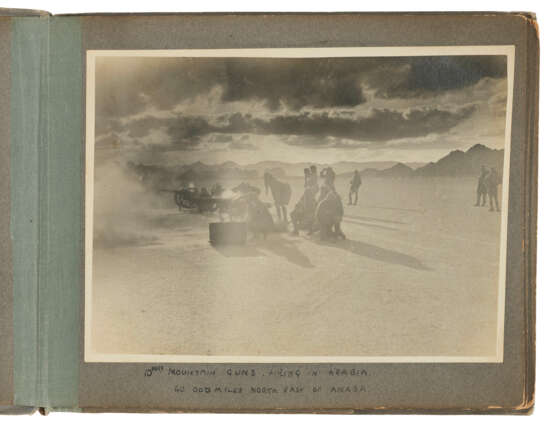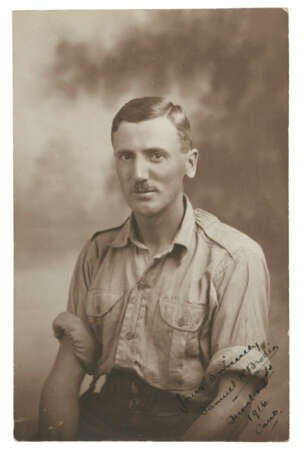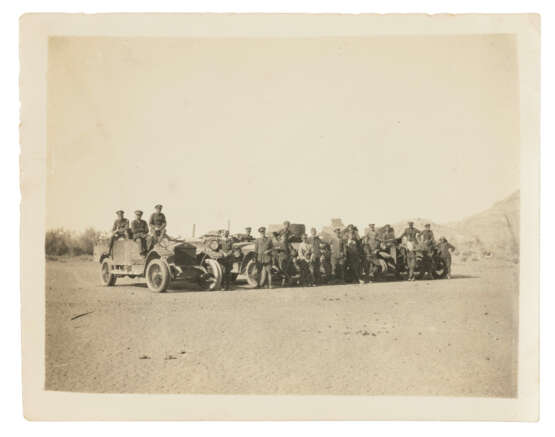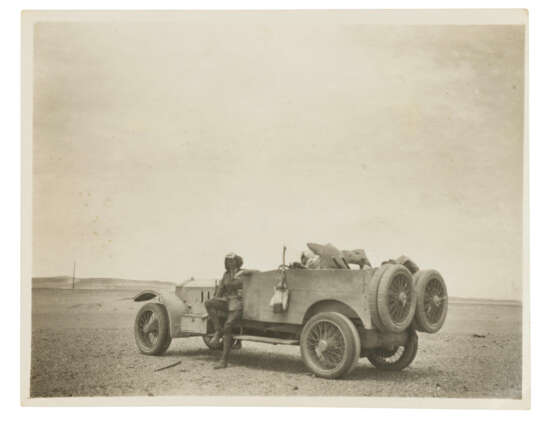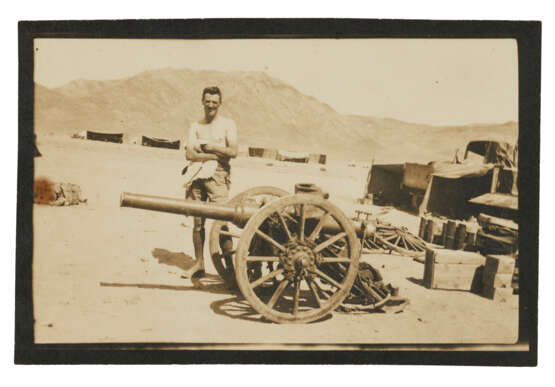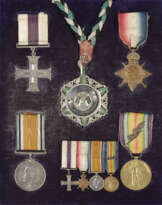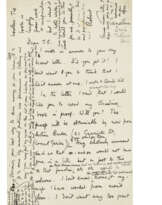ID 794572
Lot 234 | THE ARAB REVOLT (1916-1918)
Estimate value
£ 4 000 – 6 000
A collection of memorabilia and over 250 photographs relating to Samuel Brodie’s service with T.E. Lawrence during the Arab Revolt.
Lots 233 to 235 are offered by descent from Samuel H. Brodie, a lieutenant in the Royal Field Artillery (R.F.A.), who served under T.E. Lawrence during the Arab Revolt, 1917-1918. Based at Azrak, the oasis near Aqaba, from where Lawrence led the raids to disrupt the Turkish Army’s Hejaz Railway, Brodie commanded, along with his fellow officer George C. Pascoe, the Ten-Pounder Talbot Battery attached to the Hejaz Armoured Car Company (see 'Nominal Roll: Hejaz Armoured Car Company', Seven Pillars of Wisdom, Appendix I).
A collection of over 250 photographs, loose and in albums, mostly relating to the Arab Revolt during World War I, including: images of Brodie, Pascoe, and of the men in the Hejaz Armoured Car Company, along with their armoured cars, various transports and guns, their encampments and accompanying Arab and Bedouin troops and Camel Corps; a collection of 6 large photographs mostly of First World War British aircraft; a collection of large-format images of mostly British guns and aircraft in Palestine, as well as German transport and camps; and some images of urban scenes from Akaba, Ma'an, and Wedj. Various places, many annotated by Brodie on versoes, Arabia, Egypt, and Palestine.
[Sold with:] An early 20th-century Arab agal [head circlet used to secure a keffiyeh or head-covering] worn by Brodie during the campaign, formed of a double circlet of light grey silk threads bound at intervals with blue-green silk threads and copper wire, terminating in two loops connected by a cord with a tassel of grey silk threads (approx. 990mm long without cord, some light soiling and staining, a few threads loose and fraying). In the 'Twenty-Seven Articles' to Lawrence's compendium for British officers working with Arabs (August 1917) he advised them to 'Wear an Arab headcloth when with a tribe. Bedu have a malignant prejudice against the hat ... if you wear a hat your best Arab friends will be ashamed of you in public'. (J. Wilson, Lawrence of Arabia, 1989, Appendix IV, p.963).
[And:] A small collection of memorabilia pertaining to Brodie's relationship with T.E. Lawrence, including correspondence with A.W. Lawrence, and printed material from T.E. Lawrence's funeral.
Lawrence’s description of Brodie’s artillery unit gives the reader a flavour of the men and machines:
‘… the mountain-gun section on Talbots … was an odd unit which General Clayton had seen in Egypt, and had sent down to us in an inspired moment. Its six Talbots, specially geared for heavy work, and were good, but inferior to the Rolls in having artillery wheels (unstable in our changing climate) and only single wheels in front. This made them less nimble than the armoured cars over treacherous surfaces, and in addition their torque-rod brackets were too weak and were continually breaking, until at last the railway workshop in Cairo made us a set in phosphor-bronze, and forever cured that difficulty.
'They carried two ten-pounder guns, and were manned by British gunners who were technically excellent. It was wicked to have given good men such rotten tools; yet the inferior weapons were hardly noticeable in the greatness of the spirit of the men. Their Captain [sic] Brodie was a silent Scotsman, never very buoyant or very anxious, a man whom difficulties were shameful to notice, and who stamped himself on his subaltern, Pascoe, and on his men. However hard the duty given them, they attacked it with such untroubled determination that their will always prevailed. Brodie seemed able to pick up his unit, and carry it forward with him over every obstacle. On every occasion and in every crisis they were always in place at the right moment, perspiring but imperturbable, with never a word in explanation or complaint.’ (Seven Pillars of Wisdom, Oxford ed., p.517; 1935 ed. p.458).
Lawrence himself was an exponent of mobile armoured warfare, and laid out his thoughts in ‘Evolution of a Revolt’, first printed in the Arab Bulletin, and then reprinted in Oriental Assembly (1939, pp.126-7). General Clayton was obviously of the same mind, and Brodie was sent to Matruh in Egypt’s Western Desert in February 1917 to raise such a mobile artillery unit.
The archive described above contains over a dozen photographs of Matruh (mainly in the grey photograph album) which must date to the beginnings of the unit. After testing and training, Brodie was then sent with his new unit to the Hedjaz, arriving in Aqaba on 21 November 1917. Initially, the Talbots were used for transporting stores and personnel, including Prince Feisal, up to Guwaira, where a road was being prepared; one photograph in the present collection, dated December 1917, appears to show this very road-making. Once encamped at Guwaira, the Talbots joined the armoured Rolls-Royces to form the Hejaz Armoured Car Company. Military operations started in earnest on 1 January 1918, with an attack on Tel El Shahm station, followed 6 days later with an attack on Mudawwara station. This latter was attacked a number of times over the course of the year, and there are three photographs of this location, complete with views of the remains of the station’s water tower and demolition of the station’s well. Operations in this area required fuel and supply dumps, and one was created at a location known as Tooth Hill, which appears in at least three photographs in this collection.
It is notable that because of problems with resupplying such a unit with petrol, Lawrence’s Hejaz Armoured Car Company rarely ventured more than 100 miles from their operating base. Nonetheless, as Brodie’s War Diary makes clear, the unit was actively and effectively engaged in multiple attacks on the Hedjaz Railway. Besides artillery assaults from ranges of 2000-3000 yards, the gunners were also ‘hands-on’ – there is a photograph in the archive showing gunners standing over the rails actively in the process of destroying railway points.
It is not clear whether Lawrence and Brodie kept in touch after the war (Pascoe did meet Lawrence once). However, after Lawrence’s death, his brother, A.W. Lawrence, ‘decided that, in the case of a man [his late brother, T.E.] with so many facets, a collection of first-hand material would be more illuminating, as well as more authoritative, than an official biography’ (T.E. Lawrence by his Friends, preface) and wrote to Brodie asking for his impressions of T.E. In the present archive, there is a typescript copy of the letter Brodie wrote to A.W., an edited version of which appears in T.E. Lawrence by his Friends.
References: ‘George C. Pascoe’ in The Journal of the T.E. Lawrence Society. Vol. IX, No. 1 Autumn 1999, pp.28-34; H. St. J.B. Armitage & J.H. Pascoe, ‘The 10 Pounder Motor Section R.F.A. Hedjaz Operations’ in The Journal of the T.E. Lawrence Society. Vol. X, No. 1 Autumn 2000, pp.13-48.
| Artist: | Thomas Edward Lawrence (1888 - 1935) |
|---|---|
| Place of origin: | Northern Europe, Europe, United Kingdom |
| Artist: | Thomas Edward Lawrence (1888 - 1935) |
|---|---|
| Place of origin: | Northern Europe, Europe, United Kingdom |
| Address of auction |
CHRISTIE'S 8 King Street, St. James's SW1Y 6QT London United Kingdom | |
|---|---|---|
| Preview |
| |
| Phone | +44 (0)20 7839 9060 | |
| Buyer Premium | see on Website | |
| Conditions of purchase | Conditions of purchase |
